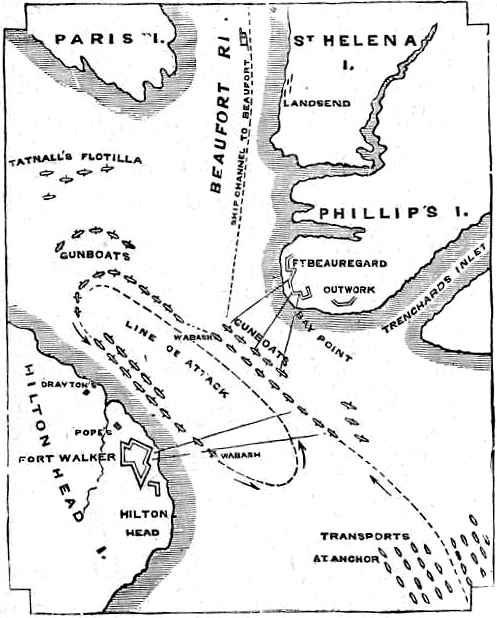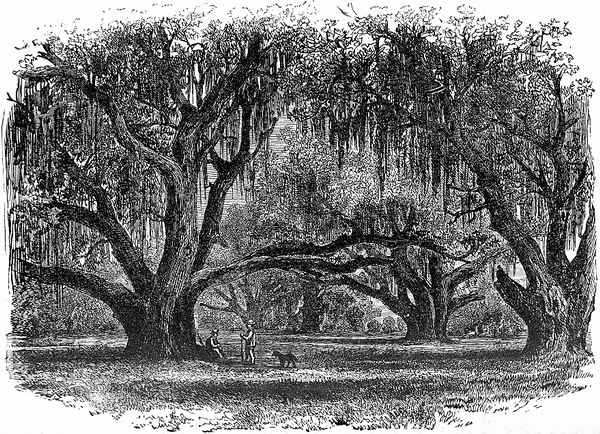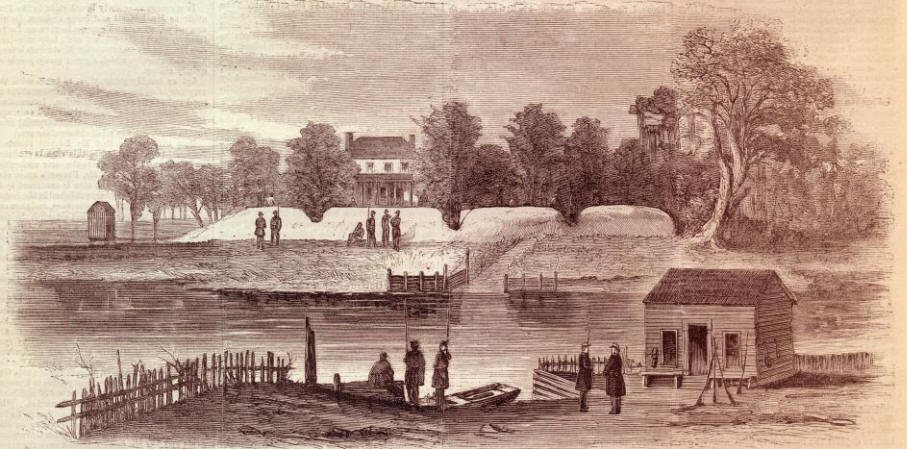
Slaves of the Rebel General Thomas F. Drayton
Background Information--This photograph, depicting a large group of slaves, was taken by Henry P. Moore at Hilton Head, South Carolina, in 1862. In 1860, fourteen prominent families and their slaves lived on Hilton Head and most spent their time off the island. At the time the picture was made, Hilton Head's population had grown to over forty thousand individuals and included Union troops, civilian storekeepers, missionaries, prisoners of war, and slaves seeking refuge from their owners.
In 1856, soldier Thomas Fenwick Drayton took control of his wife’s parents’ seven-hundred-acre Fish Haul Plantation. The plantation was largely dedicated to producing cotton. Fifty-two slaves worked and lived on the plantation. (source: J. Paul Getty Museum Education Department)
May 1862 Photograph of Drayton Plantation--Negroes Quarters--Hilton Head, SC
This image is one of several Moore made at Hilton Head. Revealing the everyday lives of slaves and former slaves, his photographs from this period include images of slaves’ living quarters and workers ginning and sorting cotton. This image depicts slaves who were in the process of being made free by the federal government. The white soldier, who was likely a Union soldier, is standing in the front as though he is overseer or master. Details of the slaves’ clothing and accessories can be seen in this picture. The women, who are all sitting in a lower position, relative to the men, are wearing wraps or kerchiefs on their heads. This African style was perpetuated in the United States by descendants of the original slaves from Africa. Although some garments worn by slaves could be bought ready-made, much of the clothing on a plantation was tailored by enslaved seamstresses. (source: J. Paul Getty Museum Education Department)

Confederate General Thomas Drayton
From the Washington Times, on 7 November 2010, "Two brothers, two flags and one battle in Port Royal," - The Civil War by Martha M. Boltz: VIENNA, VA.— November 8, 2010 — Two brothers went to war, one with the Confederate Army, the other a Union naval officer. One went north, one went south; both were involved in a naval battle of Port Royal, South Carolina, with which few are familiar, which resulted in a Union victory. Even in death they lie on opposite sides of the Mason-Dixon Line.
The problem with Fort Royal was that the larger Union troops came into the battle with a significant edge over their Confederate opponents who manned two forts, one on either side of the Sound. Fort Walker on the south near Hilton Head, had 23 guns, with 18 of them directed toward the ocean and a fort with as many as 255 men.

On the north, Fort Beauregard on Phillips Island, had 19 guns and a garrison of almost 150 men. Blockading Union ships had patrolled the area throughout the war; it was difficult for the Confederate forces to come into the Sound to refuel or take on coal.
The Union naval forces who attacked them on November 7, 1861 came ‘loaded for bear,’ as they say. The seamen, under the leadership of Flag Officer Samuel duPont, had a total fleet of 75 warships, and several thousand Marines on board, augmented by an Army of 12,000. The only equalizer was the prevailing opinion that naval forces could not outman and outgun land forces. Probably no one really expected that duPont’s men would actually attempt an attack on two forts simultaneously, which was considered to be a project for ground troops.

Still the original battle plan on November 1 had to be abandoned when typical bad Atlantic coastal weather set in. As anyone who has been on more than one Caribbean cruise can attest, the likelihood of strong winds and stronger seas is very likely as one passes Cape Hatteras. On this particular day, the storm was a good strong one, resulting in the naval fleet being scattered with several transport ships being sunk. There would be no attacking the two forts for the time being, and it would be up to duPont to find a way to make it work or face a failure.
He was aware that Cape Hatteras had been successfully attacked three months earlier, and felt that by using the force and flexibility of the steam powered ships, he could better take down the fort. DuPont directed his ships to not stop for the actual attack, but to continue moving in such a way that they literally formed an elliptical shape at the mouth of the Sound. In this manner they could attack both Fort Wagner and Fort Beauregard almost simultaneously. This provided the ships the ability to bombard the land forts in a continual barrage, continuing this method as long as was needed. It would be harder for the defenders in the fort to hit moving targets!

On November 7, his plan went into effect and the constant firing continued from 9:30 a.m. until 1:15 p.m. as duPont led his squadron into the Sound. The Rebels met this large force with four ships, a rather uneven match. It was not that much later that the Union sailors saw that the garrison troops appeared to be retreating from Fort Walker, a facet later substantiated when it was found that only three of the guns facing the attackers were still operable.
The losses were light on the Union side, only 31 had been killed or wounded. For the Southerners the figures were not as good since they counted 66 casualties. DuPont’s strategy had worked, Fort Walker was a shell of its former self and the Union Navy still had all of its ships. Shortly thereafter, Fort Beauregard was abandoned. There was now no hope that the Confederacy could prevent Union forces from coming into Port Royal Bay.

Port Royal Ferry
The net result was that the Union ended up with an invaluable asset – readily accessible stations for coal and other supplies to keep the blockaders operating. It was a doubly essential area, being located between Charleston, SC and Savannah, GA. And the Union troops had verified their opinion that these two garrisons were always low on ammunition and not staffed adequately.
They had been easy targets.center; "

Confederate Brigadier General Thomas F. Drayton and brother Union Naval Commander Percival Drayton
As to our two young brothers, Brig. Gen. Thomas F. Drayton of the 50th Georgia was a West Point graduate, part of General James Longstreet’s troops, in charge of Fort Royal. Thomas was the eldest, and after the war he went to Mecklenburg County, North Carolina where he died in 1891 and is buried.
His brother, Commodore Percival Drayton, a midshipman, was Captain of the U.S.S. Pocahontas, which was one of the Union fleet. in fact it was to him that Admiral Farragut uttered his famous order, "Damn the torpedoes,full speed ahead!" He, too, survived the war but only barely, dying in August of 1865.
He was buried in Laurel Hill Cemetery in Philadelphia. There stands today a historical marker in Beaufort County, SC, near the gated community of Port Royal Plantation, which reads as follows:

“To honor the memory of two gallant gentlemen of South Carolina. Thomas Fenwick Drayton; Brigadier General, C.S.A. and his brother Commodore Percival Drayton, U.S.N., Captain of U.S.S. Hartford, and later the first Chief of Naval Operations.
The brothers met at the outbreak of hostilities, shook hands, and Each went the way his conscience directed.
Thomas elected to defend his State. Percival to follow his flag.
On November 7, 1861 the brothers met in battle. Commander Percival Drayton, on the gunboat Pocahontas, attacked Fort Walker, on which General Thomas Drayton was in command.” (source: The Washington Times)




No comments:
Post a Comment